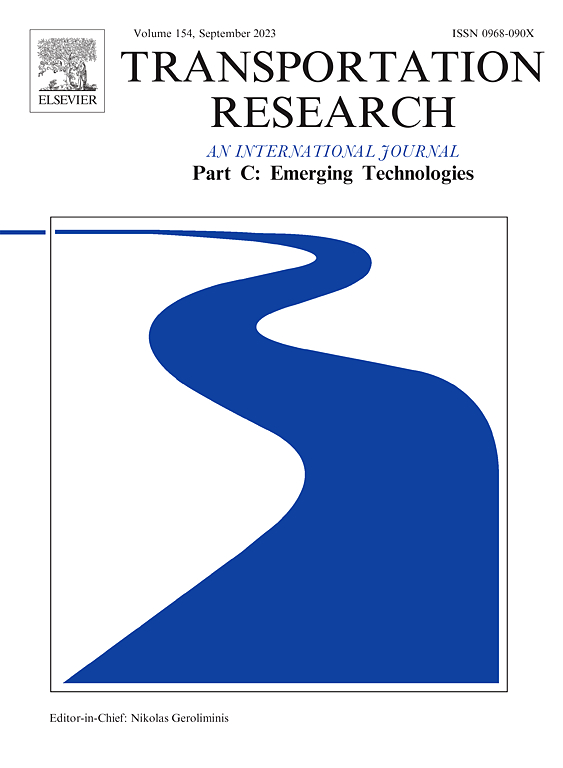Routing of autonomous vehicles for optimal total system cost under equilibrium
IF 7.6
1区 工程技术
Q1 TRANSPORTATION SCIENCE & TECHNOLOGY
Transportation Research Part C-Emerging Technologies
Pub Date : 2025-02-01
DOI:10.1016/j.trc.2025.105004
引用次数: 0
Abstract
The notion of optimal mobility via Autonomous Vehicles (AVs) controlled by a transportation management centre (TMC) has received considerable attention in the past few years. One of the novel demand management strategies entails Average Travel Time (AVT) equilibrium, a cyclic path assignment that travellers experience at the end of a fixed cycle (a period of many days) while maintaining system optimal (SO) path flows every day. However, this work is restricted to smaller networks because of the intricate solution strategies involved. To address large networks in notably lower run times, we thus put forth a linear-based AVT approach. Furthermore, applying such TMCs is limited to system time only, with system emissions receiving negligible attention. In this regard, we propose a TMC that preserves an optimal total system cost (OTSC), including travel time and emission. Unlike earlier AVT works, the average vehicle travel time and emission cost (AVTEC) equilibrium is converted from a non-linear complementarity problem to a linear problem by manipulating the inherent structure of the problem. Similar to AVT, when a fixed cycle ends, travellers from the same Origin-Destination (OD) pair will have taken distinct routes within a given path combination set in accordance with predetermined time proportions and experience equal and minimal AVTEC. Numerical investigations demonstrate that, in contrast to previous approaches to AVT, the novel linear AVTEC framework can solve extended networks significantly faster. We also investigate the mixed equilibrium (ME) scenario, in which specific travellers (referred to as non-subscribers) who choose not to subscribe to the TMC but adhere to their user equilibrium (UE) routing patterns and compete with the OTSC travellers. Results indicate that the non-subscribers will outperform the subscribers, giving non-subscribers incentives to not join the TMC. To deter this from occurring, we determine tolls upon non-subscribers/UE travellers based on the travel cost difference (TCD) between the AVTEC of TMC subscribers and the minimum UE travel cost of non-subscribers. While imposing tolls upon UE travellers, we consider their heterogeneity through their value-of-time (VOT) distribution to equalize the minimum private costs of non-subscribers with the AVTEC of subscribers. In addition, we propose link-based and sensitivity-based equilibrium strategies regarding ME, tolls and different penetration rates of subscribers and non-subscribers based on their VOT distribution to solve extensive networks.
求助全文
约1分钟内获得全文
求助全文
来源期刊
CiteScore
15.80
自引率
12.00%
发文量
332
审稿时长
64 days
期刊介绍:
Transportation Research: Part C (TR_C) is dedicated to showcasing high-quality, scholarly research that delves into the development, applications, and implications of transportation systems and emerging technologies. Our focus lies not solely on individual technologies, but rather on their broader implications for the planning, design, operation, control, maintenance, and rehabilitation of transportation systems, services, and components. In essence, the intellectual core of the journal revolves around the transportation aspect rather than the technology itself. We actively encourage the integration of quantitative methods from diverse fields such as operations research, control systems, complex networks, computer science, and artificial intelligence. Join us in exploring the intersection of transportation systems and emerging technologies to drive innovation and progress in the field.

 求助内容:
求助内容: 应助结果提醒方式:
应助结果提醒方式:


